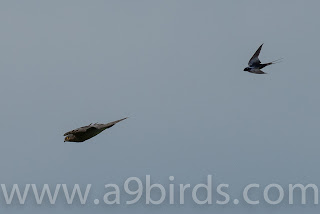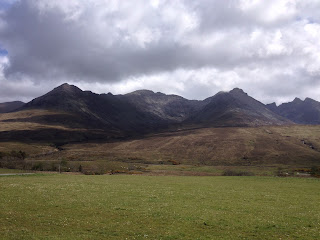Fun in the sun
Well we've had some great weather in recent weeks, with the birds making the most of the warm weather (such as letting brooding parents take short breaks from sitting on eggs) and of course the longer days.
In our part of the world, we're now at the time of year where it doesn't get dark, remaining officially in nautical twilight at its darkest until the end of July, and not officially getting to 'night' dark until the second half of August. It's one of the reasons why so many birds come up here to breed, with extended day length offering the biggest opportunity to feed as well as be aware of predators through most of the day.
Our Swallows have built a brand new nest in our workshop, and it's been great to watch them toil away. One downside of improving their security this year (see last month's blog) is that we can't put a mirror up to see if any eggs have been laid yet...hey ho, we'll know soon enough and I'd rather let them get on with things rather than disturb them. Hopefully the news of the patter of tiny wings next month! UPDATE Not more than two hours after this was published, an upping of tempo in the Swallows' behaviour indicated something had happened. Viewing from the sectioned off part of the workshop, at least three chicks have now hatched!
Bonxie-tastic
With so many things to do in the land we love, the good weather recently determined that a long-held intent to do a 'new' trip could be finally had. Handa Island sits just off the northwest coast of Sutherland, and in Spring through mid-July becomes host to a variety of seabirds as they breed in ideal conditions and locations. Although the towering stacks of auk species (Guillemots, Razorbills and Puffins) along with Fulmars and Kittiwakes are a big draw for many with the sight and sound (though not the smell!) of thousands and thousands of birds, it was the other inhabitants that I was more focussed on.
Two skua species breed on Handa, the Arctic Skua and the Great Skua - the latter being known by many as the Bonxie, derived from the old Northern Isles word 'bunksie' which means 'dumpy bird'. Skuas are big, powerful birds and usually are only seen from land whilst seawatching or whilst waterborne on a pelagic trip, powering through the air harassing gulls and other birds. So it was a real treat, therefore, to be but feet from these birds as we made our way across the island on foot. Many were sat on eggs of their own, whilst their partners were off predating nests of the seabirds mentioned above.
Once their young are hatched, you can expect the skuas to be extremely defensive of their brood and will ward off humans with low passes and even a bump to the head with their webbed feet. If you're really unlucky, projectile vomiting is also a weapon! So, if you've not 'done Handa', consider it - it's a superb place, especially when it's like this...
Do not disturb
With the fluttering of tiny wings on many nests, including our two closest Osprey nests to home, it's a timely reminder to those of you who seek the company of our feathered friends to be wary of any disturbance you may make and - in the case of Wildlife & Countryside Act 1981 Schedule 1 species - any laws you may break.
Sometimes though, the special birds will happily come to you - this Red-throated Diver (a protected Schedule 1 species) was fishing in the bay as we headed across to Handa and amazingly came towards us. Well, don't mind if I do...
Follow this link for more information:http://birdersagainst.org/schedule-1/
Happy - and responsible - birding
Mike
Well we've had some great weather in recent weeks, with the birds making the most of the warm weather (such as letting brooding parents take short breaks from sitting on eggs) and of course the longer days.
In our part of the world, we're now at the time of year where it doesn't get dark, remaining officially in nautical twilight at its darkest until the end of July, and not officially getting to 'night' dark until the second half of August. It's one of the reasons why so many birds come up here to breed, with extended day length offering the biggest opportunity to feed as well as be aware of predators through most of the day.
Gadaggadaggadagga - one of our Swallows dogfights the local male Sparrowhawk
Our Swallows have built a brand new nest in our workshop, and it's been great to watch them toil away. One downside of improving their security this year (see last month's blog) is that we can't put a mirror up to see if any eggs have been laid yet...hey ho, we'll know soon enough and I'd rather let them get on with things rather than disturb them. Hopefully the news of the patter of tiny wings next month! UPDATE Not more than two hours after this was published, an upping of tempo in the Swallows' behaviour indicated something had happened. Viewing from the sectioned off part of the workshop, at least three chicks have now hatched!
Bonxie-tastic
With so many things to do in the land we love, the good weather recently determined that a long-held intent to do a 'new' trip could be finally had. Handa Island sits just off the northwest coast of Sutherland, and in Spring through mid-July becomes host to a variety of seabirds as they breed in ideal conditions and locations. Although the towering stacks of auk species (Guillemots, Razorbills and Puffins) along with Fulmars and Kittiwakes are a big draw for many with the sight and sound (though not the smell!) of thousands and thousands of birds, it was the other inhabitants that I was more focussed on.
Arctic Skua on patrol
Two skua species breed on Handa, the Arctic Skua and the Great Skua - the latter being known by many as the Bonxie, derived from the old Northern Isles word 'bunksie' which means 'dumpy bird'. Skuas are big, powerful birds and usually are only seen from land whilst seawatching or whilst waterborne on a pelagic trip, powering through the air harassing gulls and other birds. So it was a real treat, therefore, to be but feet from these birds as we made our way across the island on foot. Many were sat on eggs of their own, whilst their partners were off predating nests of the seabirds mentioned above.
Bonxie up close
Once their young are hatched, you can expect the skuas to be extremely defensive of their brood and will ward off humans with low passes and even a bump to the head with their webbed feet. If you're really unlucky, projectile vomiting is also a weapon! So, if you've not 'done Handa', consider it - it's a superb place, especially when it's like this...
Do not disturb
With the fluttering of tiny wings on many nests, including our two closest Osprey nests to home, it's a timely reminder to those of you who seek the company of our feathered friends to be wary of any disturbance you may make and - in the case of Wildlife & Countryside Act 1981 Schedule 1 species - any laws you may break.
Sometimes though, the special birds will happily come to you - this Red-throated Diver (a protected Schedule 1 species) was fishing in the bay as we headed across to Handa and amazingly came towards us. Well, don't mind if I do...
Follow this link for more information:http://birdersagainst.org/schedule-1/
Happy - and responsible - birding
Mike
A9Birds is a birdwatching and wildlife photography company based in Moray, covering the local area including Strathspey, the Moray Firth and Inverness-shire. Please see our website for details of what we can offer you, and why not keep up to date with our sightings and photos on our Facebook page. All photos on this page are copyright Mike Crutch/A9Birds.









Comments
Post a Comment